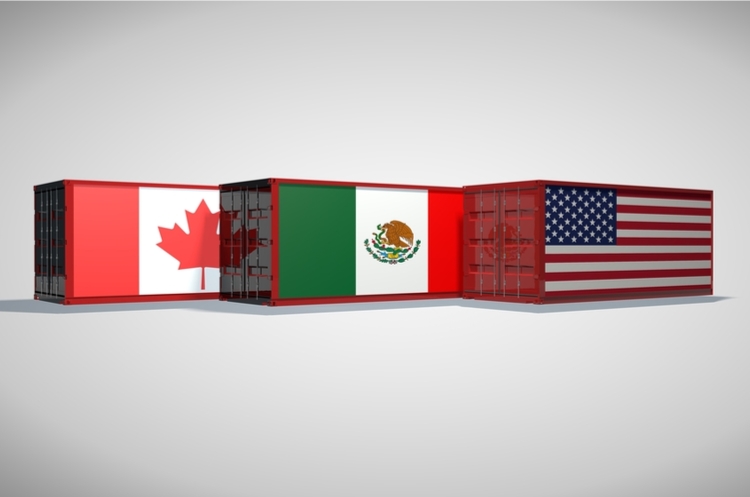Trump and Trade - A Closer Look at "Fair" Trade

The Montreal round of NAFTA talks is now finished and round seven, this time in Mexico City, has begun. Donald Trump went to the World Economic Forum in Davos and told everyone that he does not want to isolate America, he just wants trade to be “fair.” The meaning of “fair” is, of course, the big question. He also wants “reciprocal” trade agreements. He singled out centrally-planned economies as being “very unfair” to America. So I guess China will need to change its form of government in order to trade with Trump’s America; not good news for Walmart.
It makes some sense to back away from all of this for a moment and look at trade deficits in the United States and why they have persisted.
One of the keystones of the global financial system established at the instigation of the United States after the second world war was the Bretton Woods Agreement. It established a gold-based system for the exchange of currencies in an effort to stimulate global trade. But, maintaining an ever-increasing gold reserve and keeping the price of that reserve fixed became a burden, so the United States backed out of the gold standard arrangement in 1973. The U.S. dollar remained the world’s reserve currency, but lost its gold backing.
Being the global reserve currency means that U.S. dollars are always in demand by countries to hold in reserve rather than spend. This supports the value of the U.S. dollar in ways that no other currency enjoys. Other currencies appreciate and depreciate against the U.S. dollar, but it is unusual for there to be a significant movement in the U.S. dollar against all other currencies.
The consequence of this is that the United States will normally have a global trade deficit because its currency is the strongest in the world. If it stopped being the global reserve currency that would change, and it might change under the Trump Administration, but so far that has not happened and eliminating the trade deficits associated with it is a very tall order.
This has not been bad for the United States because, by and large, goods and services from elsewhere are cheaper in America. In a normal foreign exchange model, the conversion of U.S. dollars into foreign currencies to buy foreign products would reduce the value of the U.S. dollar. That does not happen, in part, as a result of the imbedded demand for the U.S. dollar as a global store of value.
It is evident that the Trump Administration does not buy this particular economic theory. Mr. Trump would have switched on the TV by the second paragraph. Robert Lighthizer’s mandate is to exactly balance all trade at all times with each individual nation. Some would say that this is a foolish effort doomed to have many serious foreseeable and unforeseeable consequences. No one is listening to those people in the Trump White House.
In the Montreal round of NAFTA negotiations, Canada’s negotiating team put together some proposals for debate. They were:
- On automobile content, the rules of origin should include research and development of new technologies (electric and autonomous vehicles, for example) as well as investment in new and some old plants and the use of NAFTA-sourced steel and aluminum. Those numbers can be quite large and would make the American goals of 85% North American content and 50% U.S. content achievable. This suggestion tests the theory that the Trump Administration is only interested in the win, not the content of the win. Adopting this suggestion would meet the stated goal without changing anything materially, and was broadly supported by the auto industry. Ambassador Lighthizer derided it as changing nothing and rejected it in his closing remarks.
- On periodic review of NAFTA, Canada proposed that periodic review be limited to potential amendment, but not termination. This is more about semantics than reality as the system we have now permits NAFTA to be terminated fairly readily, as we have seen. Canada’s goal appears to be to treat termination as an extraordinary measure rather than a regularly scheduled event.
- On Chapter 11, which deals with investors from one country suing the government of another country if they feel their business interests have been unfairly harmed, there appears to be debate. The United States wants the ability to opt out of this provision, probably because it would make its punitive “anti-dumping” tariff strategy harder to pursue. Canada and Mexico have suggested that Chapter 11 not apply to the United States. This would mean that Canadian and Mexican investors could not sue the U.S. government, but U.S. investors would also not be able to sue the Canadian or Mexican governments. Since Canada has lost a lot of Chapter 11 decisions and the United States has not, this suggestion is unlikely to be popular with the United States. Predictably, Mr. Lighthizer has characterized the Canadian response as “unfair.”
Mr. Lighthizer used strong language to suggest that Canada in particular is not negotiating in good faith, that Canada has a significant trade surplus with the United States and that Canada was being unreasonable when it suggested that trade arrangements should benefit all parties, not only one of them. His closing remarks were quite pointed. This talk has been kindly described as “rhetoric.” It was probably not intended for a Canadian audience, but rather to weaken the image of Canada in American eyes. Mr. Lighthizer only speaks to American reporters.
Two additional rounds of negotiations have been scheduled and the Trump Administration is apparently going to ask Congress for a three-year extension of the “fast track” trade promotion authority. This is the process under which the Trump Administration can negotiate deals and Congress can only vote to accept or reject them.
While these developments have been largely viewed as positive, I am not so sure. Terminating NAFTA would likely put the implementation of changes into the hands of Congress, who are unlikely to change anything. The extension of the fast track process gives the Trump Administration more time and freedom to wear Canada and Mexico down and to fill the American airwaves with rhetoric designed to gather support for the Trump Administration’s protectionist agenda. More rounds may be seen as part of the same plan.
My personal view remains that a successful outcome to these talks is as unlikely after round six as it was after round five. It is very important that Canada continue to get its message out through as many channels as possible. American public opinion matters in this process, and the Trump Administration will use any and all tactics available to it, including deliberate distortions of the truth, to make Canada look like the “bad guy” in these talks. Unlike her American counterpart, Ms. Freeland should definitely be speaking to reporters from the other side.
I recently had the pleasure of hearing David Frum speak on this topic. One of his observations was that Vice-President Mike Pence, a former state governor, keeps in close touch with current state governors. The majority of U.S. states have significant economic ties to Canada and/or Mexico and would face material disruption if NAFTA were to fail. Mr. Frum observed that Mr. Pence and the governors themselves keep this message in front of the President. This may be part of the reason Mr. Trump has not moved more quickly to terminate NAFTA. Another issue may be the emergence in Mexico of significant anti-American sentiment in the run-up to Mexico’s Presidential elections. A unilateral termination of NAFTA by the United States would be a boon to the election hopes of Andres Manuel Lopez Obrador. A lot of Republicans, including John Kelly, think that an Obrador Presidency in Mexico would be very difficult for the United States.
It looks like all of this is tending to stall talks. It is unlikely, for example, that Republicans in states with ties to Canada and Mexico want to run in their mid-term elections in an environment where NAFTA has blown up. Mexican Presidential candidates also do not want that outcome. And Canada has no interest in acceding to American demands. So I predict stasis. A lot of rhetoric from the Trump Administration, a lot of posturing, a lot of earnest interviews with Ms. Freeland, and nothing much of consequence for now. However, the Trump Administration is nothing if not unpredictable, so only time will tell.
In the meantime, we see the latest manifestation of the anti-dumping strategy mentioned above in the Trump Administration’s recent announcement of tariffs on steel and aluminum. It will be interesting to see Canada’s response. I would not look for any exemption for Canada and we may see another appeal to the WTO from Ms. Freeland.

